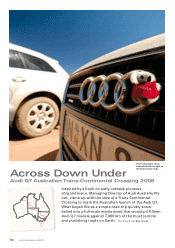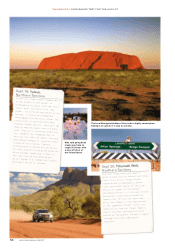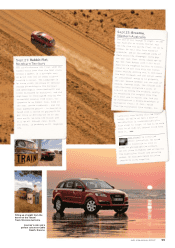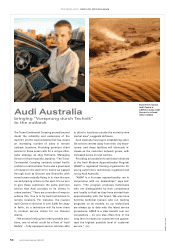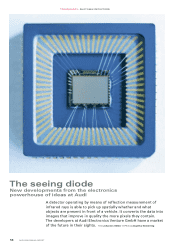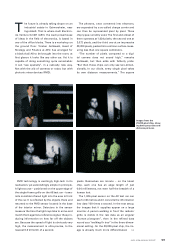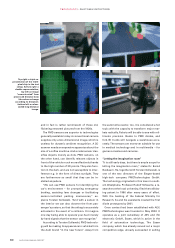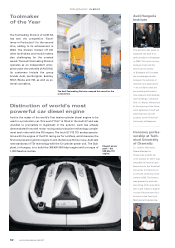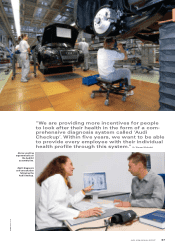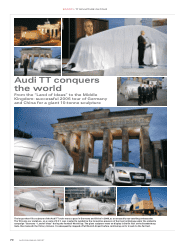Audi 2006 Annual Report Download - page 62
Download and view the complete annual report
Please find page 62 of the 2006 Audi annual report below. You can navigate through the pages in the report by either clicking on the pages listed below, or by using the keyword search tool below to find specific information within the annual report.
Top right: a triple re-
presentation of the 1,024-
pixel chip in the test
setup; bottom right: a
double representation;
top left: an image
“reconstructed” from
processed distance data
(the colours change
according to distance);
bottom left: a colour-
coded long-distance
image.
TECHNOLOGY: PHOTOMIX DETECTORS
60 AUDI 2006 ANNUAL REPORT
and in fact is rather reminiscent of those old,
flickering newsreel pictures from the 1920s.
The PMD sensors are superior to technologies
generally available today. A conventional camera
supplies only a two-dimensional image, which is
useless for dynamic ambient recognition. A 3D
scanner needs an expensive apparatus about the
size of a coffee machine. And a radar sensor clas-
sifies objects merely as dots. PMD sensors, on
the other hand, can identify relevant objects in
front of the vehicle much more effectively thanks
to the high number of 3D points. They also func-
tion in the dark, and are not susceptible to inter-
ference e.g. in the form of direct sunlight. They
are furthermore so small that they can be in-
stalled anywhere.
“We can use PMD sensors for identifying the
car’s environment – for prompting emergency
braking, assisting lane changes or facilitating
sensor-controlled parking manoeuvres,” ex-
plains Torsten Gollewski. “And with a sensor in
the interior we can also observe the front pas-
senger’s posture, so that the airbag is accurately
activated in the event of a collision. Or imagine
one day being able to operate your Audi merely
by hand signals that the sensor can recognise.”
According to Torsten Gollewski, PMD technolo-
gy will be making its appearance in vehicles from
the Audi brand “in the near future”. Away from
the automotive sector, too, it is considered a hot
topic with the capacity to transform major mar-
kets radically. Robots will be able to see with mil-
limetre precision thanks to PMD diodes, and
fork-lift trucks will navigate a warehouse accu-
rately. The sensors are moreover suitable for use
in medical technology and in multimedia – for
games consoles and cameras.
“Letting the imagination roam”
“It is still early days, but there is ample scope for
letting the imagination roam,” states Dr. Bernd
Buxbaum. He, together with Torsten Gollewski, is
one of the two directors of the Siegen-based
high-tech company PMDTechnologies GmbH.
The technology originated in this town in south-
ern Westphalia. Professor Rudolf Schwarte, a re-
searcher at the local university, filed the trailblaz-
ing patent in 1996 after many years of effort.
With the backing of the Federal Ministry for
Research, he and his assistants created the first
diode prototypes by 2001.
Once contact had been established with AEV,
PMDTechnologies was founded in May 2002. It
operates as a joint subsidiary of AEV and ifm
electronic GmbH, Essen, which is active in the
field of automation technology. The Essen
company, which has already carved out a major
competitive edge, already succeeded in selling


